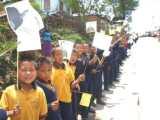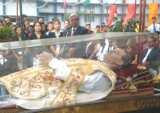Archives
Don Bosco relic in Nagaland
The following day, thousands of people from all walks of life and school students thronged the streets of Kohima city to welcome St. John Bosco’s relic which was ferried in a casket from Cathedral Church passing through the main town to Kohima Village, Kohima.
A host of Salesian Priests, students, parents, alumnus and wellwishers enthusiastically received the relic at DBS ground where a reception programme was held and Salesian priests highlighted the significance of the relic and also dwelt on the life and contributions made by St John Bosco.
 Dr. Nicky Kire MLA, an alumni, addressing the mammoth gathering recalled his days as a student of Don Bosco School, Shillong from 1962 to 1969. He extolled the contribution of Salesians of Don Bosco in the field of education and inspiring individuals. Stating that he was not belittling the contributions of other schools, he said that most of the top officials at the helm of affairs in the state were either products of Don Bosco School or the Sainik Schools. Later the denizens, parents and students paid their homage and also sought blessing from the St. John Bosco’s relic.
Dr. Nicky Kire MLA, an alumni, addressing the mammoth gathering recalled his days as a student of Don Bosco School, Shillong from 1962 to 1969. He extolled the contribution of Salesians of Don Bosco in the field of education and inspiring individuals. Stating that he was not belittling the contributions of other schools, he said that most of the top officials at the helm of affairs in the state were either products of Don Bosco School or the Sainik Schools. Later the denizens, parents and students paid their homage and also sought blessing from the St. John Bosco’s relic.
On the third day of the event, St. John’s Bosco relic reached Don Bosco School Sechü Zubza and halted at Savio Home, Zubza and on the fourth and last day of the event it departed to Wokha and finally to upper Assam and Arunachal Pradesh .
The Saint’s relic was in Nagaland as part of the global tour covering 130 countries to commemorate the Bi-centenary of the birth of St John Bosco founder of the institutes of the Salesians fathers and sisters, which will be celebrated in 2015.
It may be mentioned that, in preparation for the celebration of the Bi-centenary of the birth of Saint John Bosco in 2015, the casket containing the relic, Founder of the Institutes of the Salesian Fathers and Sisters, is on a five-continent pilgrimage covering 130 countries which began on 31st January 2009. In the tradition of pilgrimage, the relics of St. John Bosco are being carried into the towns and villages, neighbourhoods and centers where the Gospel is preached among the young and the poor today.
 The relics of Don Bosco have been recomposed from the urn that contained his remains since 1929 when the body was exhumed for his beatification and canonization. The bones and tissues of the right hand and arm have been taken and placed within a wax replica of St. John Bosco’s body, which in turn is enclosed in a large urn. The urn was constructed specially for this pilgrimage. It is composed of a large glass box in which the wax replica is placed and easily viewed. The box is mounted atop a large wood and metal cart. Among the urn’s decorations are the words, “Da mihi animas, ceatera tolle,” which translates to, “Give me souls, take away the rest,” one of Don Bosco’s many quotes that guided his ministry from its earliest stages through today. Images of young faces also surround the urn, as well as maps showing where the Salesian Family is present today. Finally, the year 1815 and 2015 are placed near the base, serving as a reminder of the purpose of this Relic Pilgrimage: in 2015, the Salesian Family, and the Church as a whole, will celebrate the 200th Anniversary of Don Bosco’s birth in 1815.
The relics of Don Bosco have been recomposed from the urn that contained his remains since 1929 when the body was exhumed for his beatification and canonization. The bones and tissues of the right hand and arm have been taken and placed within a wax replica of St. John Bosco’s body, which in turn is enclosed in a large urn. The urn was constructed specially for this pilgrimage. It is composed of a large glass box in which the wax replica is placed and easily viewed. The box is mounted atop a large wood and metal cart. Among the urn’s decorations are the words, “Da mihi animas, ceatera tolle,” which translates to, “Give me souls, take away the rest,” one of Don Bosco’s many quotes that guided his ministry from its earliest stages through today. Images of young faces also surround the urn, as well as maps showing where the Salesian Family is present today. Finally, the year 1815 and 2015 are placed near the base, serving as a reminder of the purpose of this Relic Pilgrimage: in 2015, the Salesian Family, and the Church as a whole, will celebrate the 200th Anniversary of Don Bosco’s birth in 1815.
The urn weights 820 kilograms. The glass box, containing the relics, is 253 centimeters long, 108.3 centimeters wide (over 40 inches), and 132 centimeters tall. The full urn is transported via two specially designed and built trucks.
Xavier Rutsa

